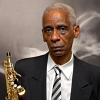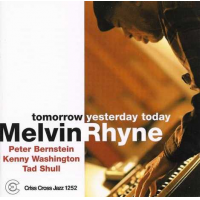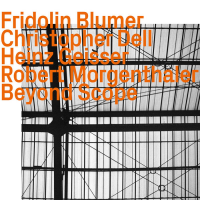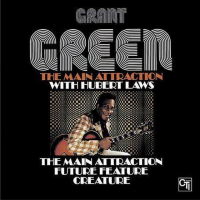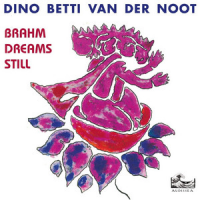Home » Jazz Articles » Liner Notes » Reed Rapture In Brooklyn: A Box Set Of Woodwind Duets Wi...
Reed Rapture In Brooklyn: A Box Set Of Woodwind Duets With Ivo Perelman
Born in Sao Paulo Brazil, Perelman, during his youth, studied multiple instruments before settling on the tenor saxophone. He even recorded an album on which he exclusively plays cello, Strings (Leo, 1997). From the time he moved to the USA in the early 1980s he became primarily an autodidact. Perelman's improvisational facility as well as his restlessly explorative mind make his prolific output as impressive in its originality and quality as it is in its size.
Starting with his superb, 1989 eponymous debut on the K2B2 inprint Perelman has continued to push his own limits. Even though in the 1990s he recorded unique interpretations of Brazilian and Jewish traditional songs as well as his and others' compositions, most of his 100 or so releases have been entirely improvised. He has forged meaningful relationships with several like minded artists that has allowed his singular style to further evolve and mature. Other writers have likened Perelman to such greats as Gato Barbieri, Albert Ayler and John Coltrane. Although such comparisons are meant to be flattering they do not do justice to either his creative vision or his brilliance. Perelman simply is Perelman. Moreover the narrow categorization of his music as Avant-Garde or Free Jazz oversimplifies his work's impact. Perelman spontaneously creates the pieces he performs, often in response to his collaborators, making them living breathing entities. As a visual artist with collectable canvases and drawings, Perelman also contributes the majority of the cover art of his albums which matches the intricacy and vibrancy of the music within.
In 2021, to celebrate his 60th birthday, Perelman released a nine volume box set called Brass And Ivory Tales on the Fundacja Sluchaj label. This magnum opus, seven years in the making, paired Perelman with a different, adventurous pianist on each disc. The improvised dialogues were often the first formal meeting between the two musicians and the instant and rapidly evolving synergy is thrillingly fresh and rewarding. Simultaneously exceptional and not surprising is Perelman's ability to maintain his individuality yet match the style of each of his partners. This is expected as Perelman thrives on camaraderie in his creative process.
In 2022 Perelman plans to outdo himself not only with this sumptuous 12 part work, Reed Rapture in Brooklyn, but also a set of one on one recordings with guitarists.
The current release is a celebration of reed instruments, particularly the saxophone and the clarinet. Recorded over six months in 2021, these sessions, each featuring Perleman with another idiosyncratic artist, are veritable who's who of modern improvisers. In addition to covering a kaleidoscopic range of sound, ten different saxophones and three members of the clarinet family, these dates are testament of Perelman's dynamic musical evolution.
Saxophonist Lotte Anker's style is perhaps the closest to Perelman's among those featured here. Born and based in Copenhagen Denmark, Anker is also an intrepid innovator whose own work includes adventurous, notated compositions as well as spontaneously created music. In this session she alternates between alto and soprano saxophones intriguingly complementing Perelman's imaginative ideas with her own.
The two, stream-of-consciousness, extemporizations mirror one another's passion as they engage in a vibrant and fiery duet. This stimulating repartee grows and evolves with thrilling energy throughout the disc. There are moments of serene contemplation formed around silent pauses that, nevertheless, are spiced up with bursts of honks and squawks. Later the languid, dissonant lines converge, interweave and diverge with an impact that is simultaneously cerebral and emotive. As Perelman explores the higher ranges of his tenor and Anker the lower ranges of her alto their tonalities reach a harmonious balance that lilts despite the music's angularity.
There are hauntingly nocturnesque instances with the two saxophonists meandering in a darkly mystical ambience. Their chant-like exchanges are part lyrical dialogue and part spiritual musings. With them Perelman and Anker express a range of abstract yet relatable concepts that, at times, are quite pensive and at others delightfully visceral.
In contrast, elsewhere, the performances become electrifyingly animated as the concurrent twittering saxophones climb and descend the scales with breathtaking agility. Although most of the tracks are long, Anker and Perelman create the same impact within a brief period of time as well. For instance "Eight" lasts less than 90 seconds, yet it is a mesmerizing crystallized sonic gem fully showcasing this fascinating creative camaraderie.
In comparison, the meeting with Joe Lovano, who is heard here on two uncommon saxophones, mezzo soprano and C-melody, is more extroverted with buoyant tones and crisp, fast exchanges. This does not mean the duet is not nuanced. Indeed, there are moments of almost pastoral quietude especially as Lovano's mezzo-soprano phrases interweave with Perelman's tenor for a deeply moving spontaneous poetry.
Originally from Cleveland Ohio and currently living in New York, Lovano has established himself as one of the most singular of the "mainstream" saxophonists with an impressive discography. His approach to improvisation has always been superbly innovative and it is intriguing to hear him let loose in this completely extemporized setting. This is not surprising given Lovano's recent output.
The instrumental banter between the two men is spirited and exciting. The C-melody's voice-like sounds serve Lovano's conversational style well and when matched with Perelman's high tenor notes create a sublime and dramatic dialogue. Blues tinged melodic fragments also permeate some of these exchanges. Occasionally there are radiant yet wistful series of overlapping phrases as well as exuberant passages laced with whimsy yet containing an undercurrent of profound soulfulness. The recording concludes with a brief series of joyous march-like refrains. Despite not having recorded together before Lovano and Perelman are sublimely in sync making this recording a high point in both their careers.
Another thoughtful pairing is the session with David Murray who plays exclusively bass clarinet here. The warm, mellow tones of Murray's instrument contrast with Perelman's tenor's sinewy and acerbic sound for a thrilling effect. The duet at times languid and melancholic and others crisp and brash captivates with these types of variation.
Born in Oakland California, Murray shares some of Perelman's early influences and is also category defying in his approach to creativity. In addition to being a master of the bass clarinet Murray, of course, is a singular tenor saxophonist. His familiarity with his partner's instrument is apparent here. Murray and Perelman's simultaneous improvisations echo one another without engaging in mimicry. They are more like reflections in highly individualistic mirrors. This thought provoking, chase-like, interplay sometimes burst into a dynamic, fantastical tango. Perelman and Murray utilize deceptively elemental phrases to create a mesmerizing and intricate opus. Even when alternating between a laid back trading of notes and a more passionate banter the two men build free flowing and cinematic tunes. Ones that are replete with Perelman's fiery wails and Murray's reverberating honks. Circular refrains and melodic whirls from the two instruments hypnotically merge creating complex and entrancing music, one punctuated by occasional divergent tonal clusters.
Another set of clarinet and tenor duets is the one with reedman Ken Vandermark. Even though the instrumentation is similar to that with Murray the session is quite different. Born in Warwick Rhode Island and based in Chicago Vandermark has an oeuvre as prolific and innovative as Perelman's. Both his compositions and improvisations draw on a variety of influences including the western classical repertoire. On this occasion Vandermark and Perelman collaborate on a dozen brief pieces that are eloquent, poignant and alternate between spirited discourse and wistful musing. The brevity and completeness of each track makes them the musical equivalents of a cross between freestyle poetry and flash fiction.
The two musicians respond to each other with short, crisp and perfectly matching phrases that build densely overlaid and angular pieces. The unconventional starting and stopping points give the sense of eavesdropping on a heated conversation. At times the atmosphere is more solemn, the extemporizations languid and haunting with loose yet succinct interwoven lines. There are also chant-like exchanges that grow more vibrant and delightfully dissonant and endow the music with a primal spirituality.
Another captivating balance is between moments of pastoral serenity and the two musicians' lithe, acrobatic spanning of the tonal scales. A carefree mood quickly becomes thrillingly riotous as Perelman pierces Vandermark's circular phrases with sharp and mordant tones. Vandermark in turn matches Perelman's squawks with honks of his own. The two spontaneous parallel performances converge and coalesce for a beautifully tense conclusion.
Woodwind virtuoso Vinny Golia also joins Perelman on clarinet and its darker relative the basset horn as well as the smallest member of the saxophone family the soprillo. The New York native is perhaps the one artist who has mastered the largest number of reeds and other non-European wind instruments so he switches among the three horns with suave fluidity. Like Perelman, Golia is a master improviser who draws inspiration from a wide range of sources.
Perelman's yearning lines often set a tense mood. Golia then enters with contemplative refrains and the pair launches into an explorative duet that gradually transforms into a fiery, open ended celebration of sound. The seamless flow of ideas from one to the other is electrifying and the synergy between the two musicians is sublime. Elsewhere reverberating lines from both instruments carefully merge for a richly textured abstract piece. Within a somber and expectant ambience bursts of short boisterous phrases are sandwiched between languid, pensive lines. There is an undercurrent of angst that gives the music a subtle sense of urgency.
Perelman responds to Golia's dark, expressive horn with his warm, mellifluous tenor. The intimate and dense duet is stimulatingly dramatic, particularly when both men extemporize with abandon embracing fiery dissonance. Overall Perelman and Golia's session is the most cinematic of the release and its theme is summarized beautifully in the succinct and memorable "Nine." The slightly over half a minute piece utilizes silent pauses deftly as the soprillo and tenor take turns contributing resonant melodic salvos that fade in and out for an intriguing dialogue.
Staying with the smaller saxophones, Perelman's encounter with l'enfant terrible of creative music, Jon Irabagon, is perhaps the most distinctive of the duets. This is not surprising given that both men are intrepid innovators. Their synergy though is impressive as they seem to precisely anticipate each other's moves. Born in Chicago to Filipino immigrants the New York based Irabagon defies genrism with his thought provoking releases. In this session he performs on sopranino and the rare slide soprano.
Short staccato phrases and crisp refrains form a relaxed ebb and flow of ideas between the two saxophonists. As the tempo increases as does the exigency of their exchanges. Often single notes and brief vamps construct delightfully tense and witty conversations. This style of dynamic musical banter is pushed even further when both artists utilize brief vocalizations, pops and honks to pepper their whimsical dialogue. Irabagon's sopranino flitters with agility while Perelman blows his tenor with passion and gusto as they build up to the apogee of their tense conversation and then conclude with lyrical melancholy. Perelman blows longing lines filled with subtle vibrato while Irbagon punctuates the forlorn solo with voice effects. As the two saxophones respond to one another, sometimes, a mystical mood ensues. The captivating exploration of sound and the pushing of each instrument's boundaries create a clever theatrical ambience.
Another striking pairing is with progressive improviser and educator Dave Liebman. A musical giant and stalwart of the New York Jazz scene, the Brooklyn born and based, Liebman bring's his distinctive style to this provocative duet. The eleven meditative, interlinked, pieces range from less than two minutes to over nine yet all sound equally spacious.
Some of the shorter ones are mystical and soulful with Perelman and Liebman pillowing their exchanges with haunting silence. The duo increase the tempo briefly to breakneck speed and then relax back into the solemn quietude. Often, the two saxophonists stretch out their contemplative musings into a loosely woven sonic tapestry. The laid back, simultaneously melodic and atonal, interlinked improvisations seem at times like an otherworldly waltz, one peppered with bluesy hints. Whether the musicians are conversing in long notes and expansive phrases or in short, crisp and poignant tones the ambience they create is deeply melancholic. The horns sing with bittersweet emotion and simmering passion only to conclude with an up-tempo cadence and tumultuously folkish mood.
These stimulating spontaneous conversations bear definite western classical influence that is clearly heard throughout the recording. As Perelman and Liebman mirror one another their resonant lines overlap exploring the individual motifs from different points of view. In this their performance is vaguely reminiscent of fugues yet thrillingly unstructured ones. This memorable meeting between two of contemporary music's great minds is, as expected, deeply absorbing and inspired.
From the smaller saxophones to the larger ones Perelman has covered the range with this release. His pairing with multiinstrumentalist Colin Stetson has an expectant atmosphere and intriguing sonic palette as Stetson is heard on the contrabass saxophone. Born in Ann Arbor and based in Montreal Stetson is a versatile musician who has mastered several wind instruments both reed and brass. He is known for his work both in improvised music, film soundtracks and his indie rock collaborations.
Perelman's high notes on the tenor contrast with Stetson's low growl creating a dark and haunting mood. Perelman's long, agile tenor lines rise and fall like a wailing lament over the chant-like reverberations of the contrabass. Perelman again covers the entire range of the tenor pushing his instrument to produce the highest and lowest notes and everything in between. It is when he is at the lower registers that his eloquent extemporization moves towards and diverges away from Stetson's no less erudite, laconic improvisation. Stetson, too, explores the entire chromatic span of his instrument. His vibrato, pops and tongued tones and his rumbling lines resonate with the same reserved passion as Perelman's.
There are deeply introspective moments. Stetson and Perelman take turns engaging in angular, contemplative exchanges that simmer slowly with shadowy intrigue. There are also brief bursts of energetic and dissonant phrases that emerge logically out the anticipatory backdrop like turbulent waves out of a murky sea. Regardless of the instrument or the artist wielding it, Perelman, again demonstrates his uncanny ability to create spontaneous and stimulating synergy.
On the only session that was recorded in Milwaukee Wisconsin (all others took place in Brooklyn New York) the doyen of the Association for the Advancement of Creative Music (AACM) Roscoe Mitchell is featured on the bass saxophone. One of the artists who revolutionized improvised music, the Chicago born Mitchell is known as a restless innovator. Starting with his groundbreaking classic Sound (Delmark, 1966) to the founding of the AACM and the Art Ensemble of Chicago to his later forays into western classical compositions, the octogenarian Mitchell continues to find new ways to express himself. In addition to being an accomplished artist Mitchell is a well known educator passing on the AACM torch to generations of similar minded musicians.
It is therefore not surprising that the pairing of two of the most brilliant improvisers in the field, both saxophonists, should result in a pyrotechnic duet. Fiery, here, does not apply to the amount of energy, number of notes played or the zeal with which the two men blow their horns. It is an intellectual passion laced with subtle emotion that is heard in this encounter.
The centerpiece of the disc is around forty minutes long and opens quietly with short phrases flickering like lamps in the dark silence around them. Perelman builds a lyrical improvisation with exquisite economy while Mitchell contributes deeply reverberating tones that cleverly punctuate the performance. Mitchell also logically constructs an angular and thrillingly complex melody that Perelman embellishes with his muscular free flowing lines. As the tune evolves the pair interweaves their individual musical ponderings into a dynamic yet sedate work that is contemplative and moving, bears bluesy hints, and has an understated spirituality.
The most exuberant set is the one with James Carter on baritone saxophone. Born in Detroit and based in New York, Carter is an undisputed virtuoso. In addition to playing a variety of saxophones his output has been in a wide range of styles including soulful organ trios, tribute to gypsy jazz and an effervescent concerto. On this recording Carter lets loose with his signature dynamism and matches Perelman's spontaneity and intellectual rigor with delightfully inventive extemporizations.
Perelman's undulating tenor lines flow over the baritone's dense reverberating ones. The paucity of notes at times creates a haunting mood. Gradually the two parallel improvisations grow more complex, often echoing one another while simultaneously diverging from the shared thematic path. Bursts of energetic and delightfully dissonant passages punctuate the serene, introspective melodies that the two saxophonists create. Here and there sonata fragments pepper the performance.
When the mood becomes more playful Carter honks with gusto while Perelman answers with sinewy phrases. Their fluid conversion flows freely filled with whimsy, bluesy hints as well as enthusiastic and atonal blowing. The performances are delightfully unfettered and contain small surprises. These include quotes from marches as well as segments of the queen's aria from Mozart's "The Magic Flute."
The spirited conversations simmer with soul and are often extremely mellifluous. Sometimes they are evocative of a film score with cascades of notes that intersect and scatter only to come back together in exploring the same motifs. Perelman and Carter had fun recording together and that lively wit and elation is clearly heard throughout the set.
The meeting with Joe McPhee, on tenor saxophone, is reflective and mesmerizing. Originally a trumpeter, the Miami native who calls New York home, McPhee is an autodidact on the tenor saxophone. A master improviser and an intrepid musical explorer, McPhee, in his early 80s, has not slowed down despite a long and productive career. He continues to create thoughtful and stirring spontaneous music which complements Perelman's equally expressive extemporized melodies.
McPhee's chant-like vocals underscore the two tenors' plaintive and angular duet. Their loosely interwoven lines punctuated with honks and wails construct a dynamic and stimulating multilayered piece that goes from delightful dissonance to exquisite melancholy and back. This results in a mystical ambience which Perelman's long, wistful notes and McPhee's reverberating tones enhance.
There are jubilant moments as well in the form of exuberant and rhythmic duets. Punctuated by squawks the alternating crisp and short phrases climb and descend the scales with subtle humor and sublime control.
The most dramatic moments of this contemplative set come when each musician takes an individual solo. McPhee complements his tenor's deep tones with quasi falsetto chanting while Perelman plays sinewy serpentine lines. In fact, one of the intriguing aspects of this meeting is the two tenor saxophonists' contrasting tonalities. Perelman stays mostly in the upper registers while McPhee in the lower and the result is all the more haunting specifically because they are playing the same instrument.
Finally, the pairing of Perelman with one of the most original living saxophonists, Tim Berne, is a provocative and stimulating exercise in musical communication. Born in Syracuse, New York, Berne has a distinctive style that embraces creative diversity yet retains his individuality. Almost as prolific as Perelman, Berne has recorded many classic albums for several labels, two of which he founded. An imaginative improviser he often introduces motifs from other genres as well as notated scores into his expansive performances. As such Perelman has found in Berne perfect foil for his own ingenuity and explorative spirit.
The alto's anguished wailing and the tenor's tense and almost polyphonic lines create a dramatic mood. As the sparse yet long notes from each man continue to echo one another the interplay gradually grows to include darker and more contemplative hues. The more straightforward phrases the two saxophonists play the more intricate the relationship between them and, subsequently, the piece becomes. As Perelman and Berne alternate, a few times, between fiery and emotive explorations to more sedate and somber musings they make more densely texture music. With each iteration they also perfect their already seamless synergy.
With ringing bells and carefully placed silent pauses the sonic tapestry the duo weaves is a mosaic of tones and moods. These range from the spiritual to the earthy and from the passionate to the meditative. The result is quite cinematic and impressionistically abstract.
This box set is an impressive artistic achievement. It makes for an exigent yet supremely rewarding listening experience. The pairing of various saxophones and clarinets with Perelman's tenor makes it more than just a study of timbres and sound. The contrasting and complementary tonalities and 13 unique musical personalities make it a multidimensional work that is cerebral, emotive, and spiritual. It is a testament of Perelman's ingenuity and ability to build immediate rapport with equally brilliant and open minded artists.
Perelman himself said of these sessions "Everyone of these sax duos taught me more than years of practice or college. To be able to merge in a deep creative unconscious moment with another sax almost felt like incest and being able to appreciate the merging of similar tonal qualities and techniques allowed me to internalize the other saxophonist's wisdom and years of experience. As you can hear now they are all unique players with a huge aesthetic palette so after 12 consecutive sessions I felt like a reborn musician." This music will also have a deep impact on listeners and broaden their musical horizons. It has the makings of an instant classic that will weather the test of time.
Liner Notes copyright © 2026 Hrayr Attarian.
Reed Rapture in Brooklyn can be purchased here.
Contact Hrayr Attarian at All About Jazz.
Ancora Imparo
Track Listing
Ivo - Lovano - 01; Ivo - Lovano - 02; Ivo - Lovano - 03; Ivo - Lovano - 04; Ivo - Lovano - 05; Ivo - Lovano - 06; Ivo - Lovano - 07; Ivo - Lovano - 08; Ivo - Lovano - 09; Ivo - Lovano - 10; Ivo - Lovano - 11; Ivo - Lovano - 12; Ivo - Lovano - 13; Ivo - Lovano - 14; Ivo - Berne - 01; Ivo - Berne - 02; Ivo - Berne - 03; Ivo - Berne - 04; Ivo - Berne - 05; Ivo - Murray - 01; Ivo - Murray - 02; Ivo - Murray - 03; Ivo - Murray - 04; Ivo - Murray - 05; Ivo - Murray - 06; Ivo - Murray - 07; Ivo - Murray - 08; Ivo - Murray - 09; Ivo - Murray - 10; Ivo - Anker - 01; Ivo - Anker - 02; Ivo - Anker - 03; Ivo - Anker - 04; Ivo - Anker - 05; Ivo - Anker - 06; Ivo - Anker - 07; Ivo - Anker - 08; Ivo - Vandermark - 01; Ivo - Vandermark - 02; Ivo - Vandermark - 03; Ivo - Vandermark - 04; Ivo - Vandermark - 05; Ivo - Vandermark - 06; Ivo - Vandermark - 07; Ivo - Vandermark - 08; Ivo - Vandermark - 09; Ivo - Vandermark - 10; Ivo - Vandermark - 11; Ivo - Vandermark - 12; Ivo - Mitchell - 01; Ivo - Mitchell - 02; Ivo - Mitchell - 03; Ivo - Carter- 01; Ivo - Carter- 02; Ivo - Carter- 03; Ivo - Carter- 04; Ivo - Carter - 05; Ivo - Carter - 06; Ivo - Carter - 07; Ivo - Carter - 08; Ivo - Carter - 09; Ivo - Irabagon - 01; Ivo - Irabagon - 02; Ivo - Irabagon - 03; Ivo - Irabagon - 04; Ivo - Irabagon - 05; Ivo - Irabagon - 06; Ivo - Irabagon - 07; Ivo - McPhee - 01; Ivo - McPhee - 02; Ivo - McPhee - 03; Ivo - McPhee - 04; Ivo - McPhee - 05; Ivo - McPhee - 06; Ivo - McPhee - 07; Ivo - Stetson - 01; Ivo - Stetson - 02; Ivo - Stetson - 03; Ivo - Stetson - 04; Ivo - Stetson - 05; Ivo - Stetson - 06; Ivo - Golia - 01; Ivo - Golia - 02; Ivo - Golia - 03; Ivo - Golia - 04; Ivo - Golia - 05; Ivo - Golia - 06; Ivo - Golia - 07; Ivo - Golia - 09; Ivo - Golia - 09; Ivo - Golia - 10; Ivo - Golia - 11; Ivo - Liebman - 01; Ivo - Liebman - 02; Ivo - Liebman - 03; Ivo - Liebman - 04; Ivo - Liebman - 05; Ivo - Liebman - 06; Ivo - Liebman - 07; Ivo - Liebman - 08; Ivo - Liebman - 09; Ivo - Liebman - 10; Ivo - Liebman - 11.
Personnel
Ivo Perelman
saxophone, tenorDavid Murray
saxophone, tenorJoe Lovano
drumsJames Carter
saxophoneTim Berne
saxophone, altoRoscoe Mitchell
saxophoneJoe McPhee
woodwindsVinny Golia
woodwindsJon Irabagon
saxophoneKen Vandermark
saxophoneColin Stetson
woodwindsLotte Anker
saxophoneAlbum information
Title: Reed Rapture in Brooklyn | Year Released: 2022 | Record Label: Mahakala Music
Tags
PREVIOUS / NEXT
Support All About Jazz
 All About Jazz has been a pillar of jazz since 1995, championing it as an art form and, more importantly, supporting the musicians who make it. Our enduring commitment has made "AAJ" one of the most culturally important websites of its kind, read by hundreds of thousands of fans, musicians and industry figures every month.
All About Jazz has been a pillar of jazz since 1995, championing it as an art form and, more importantly, supporting the musicians who make it. Our enduring commitment has made "AAJ" one of the most culturally important websites of its kind, read by hundreds of thousands of fans, musicians and industry figures every month.







